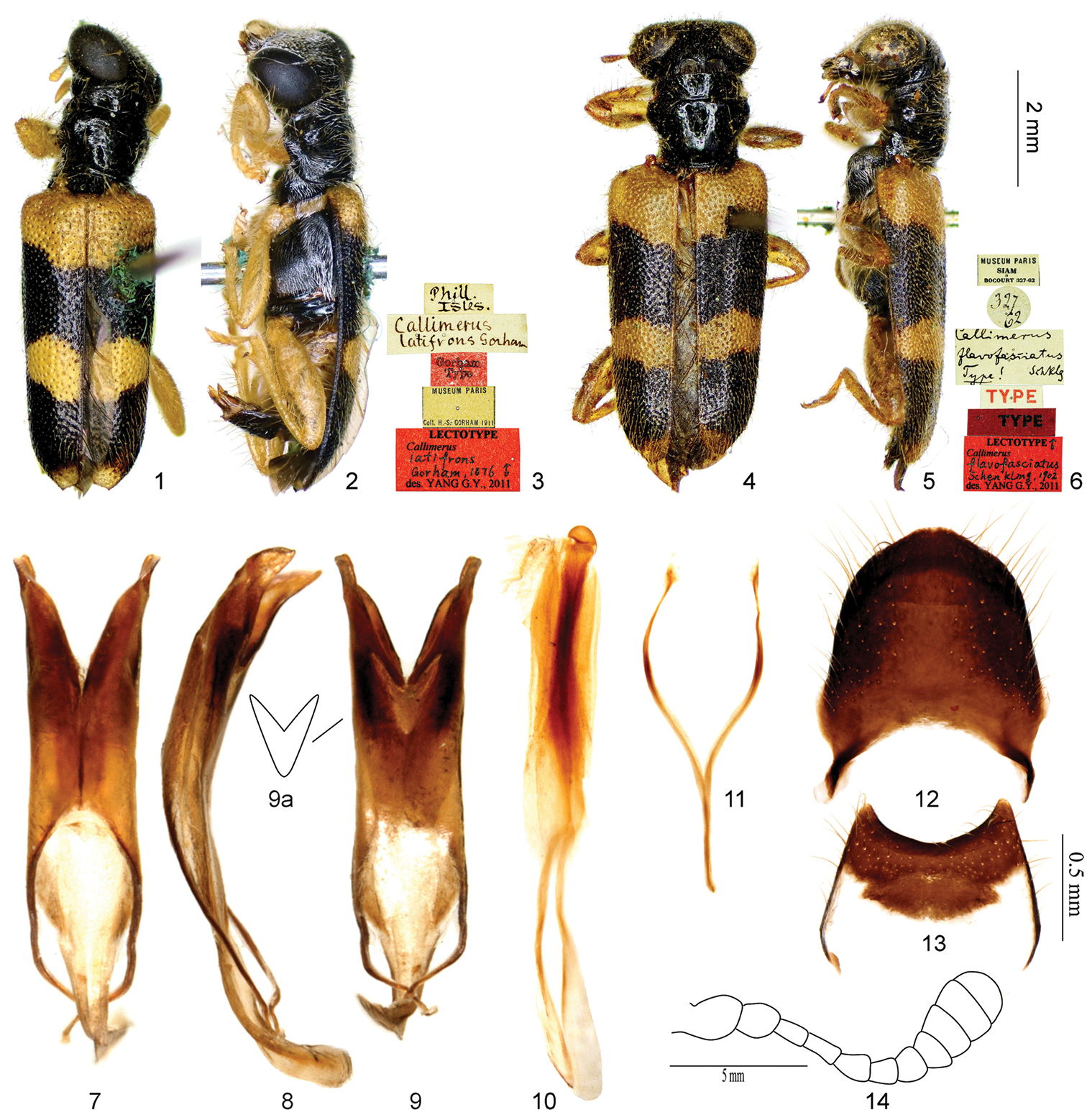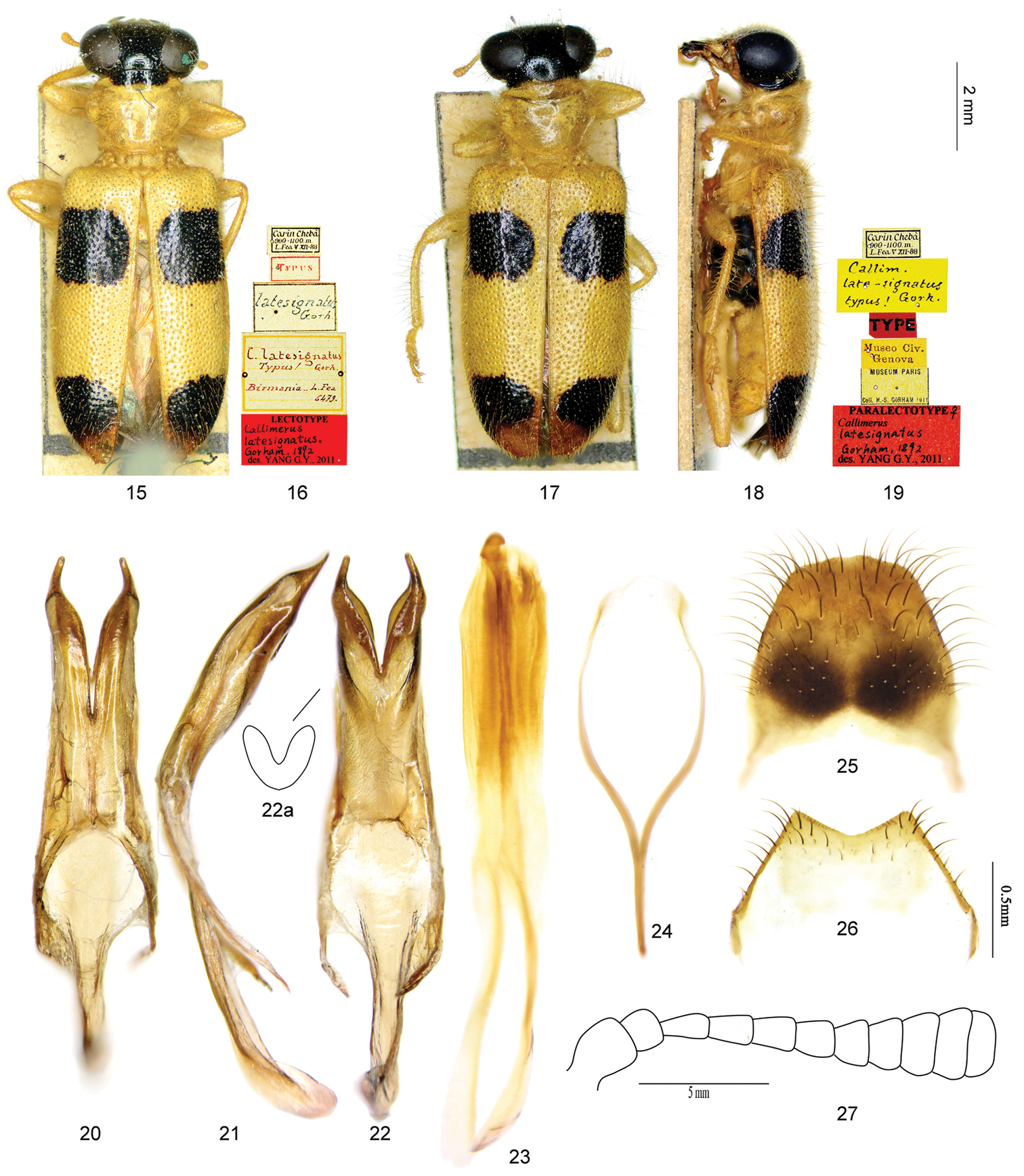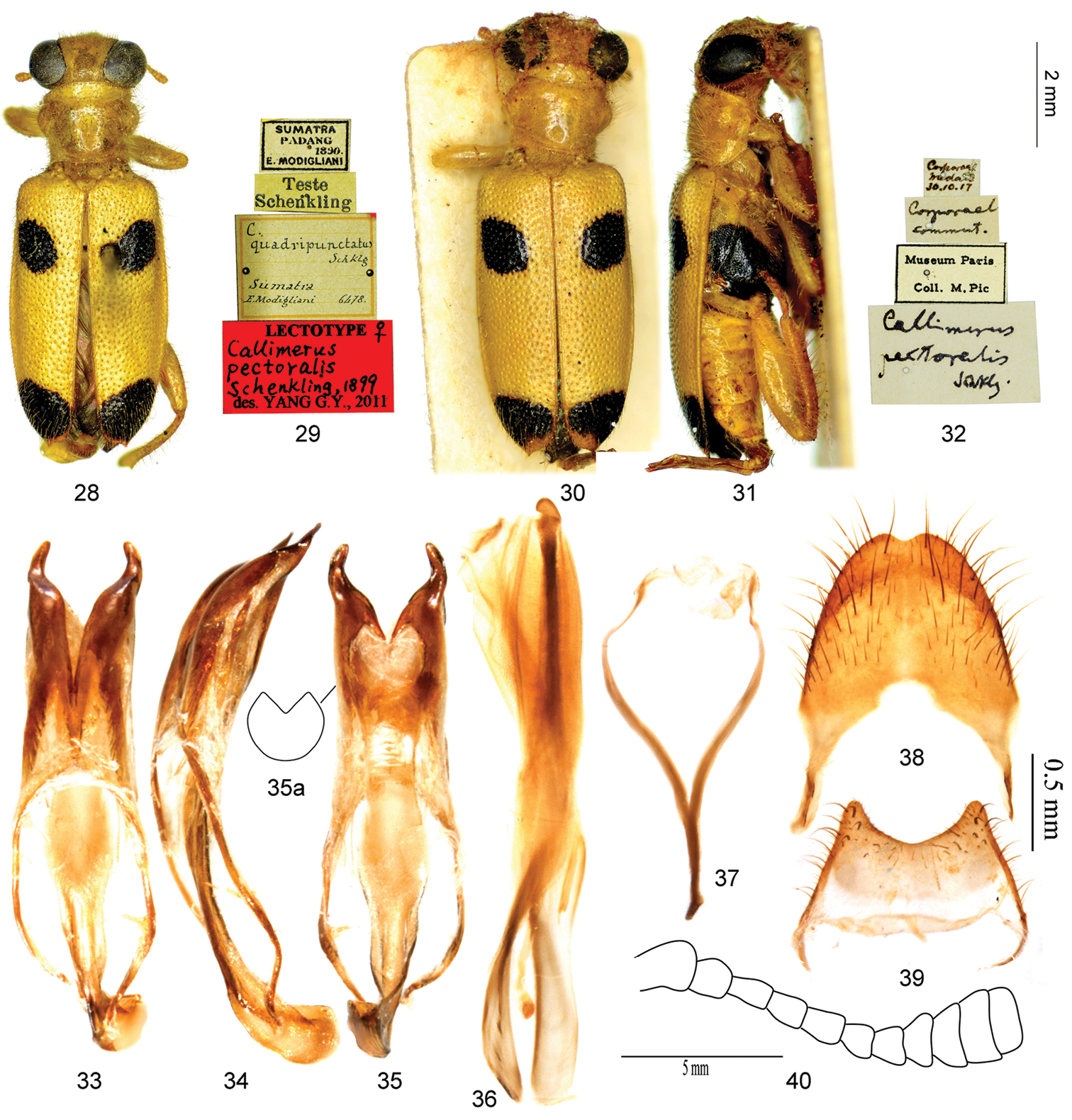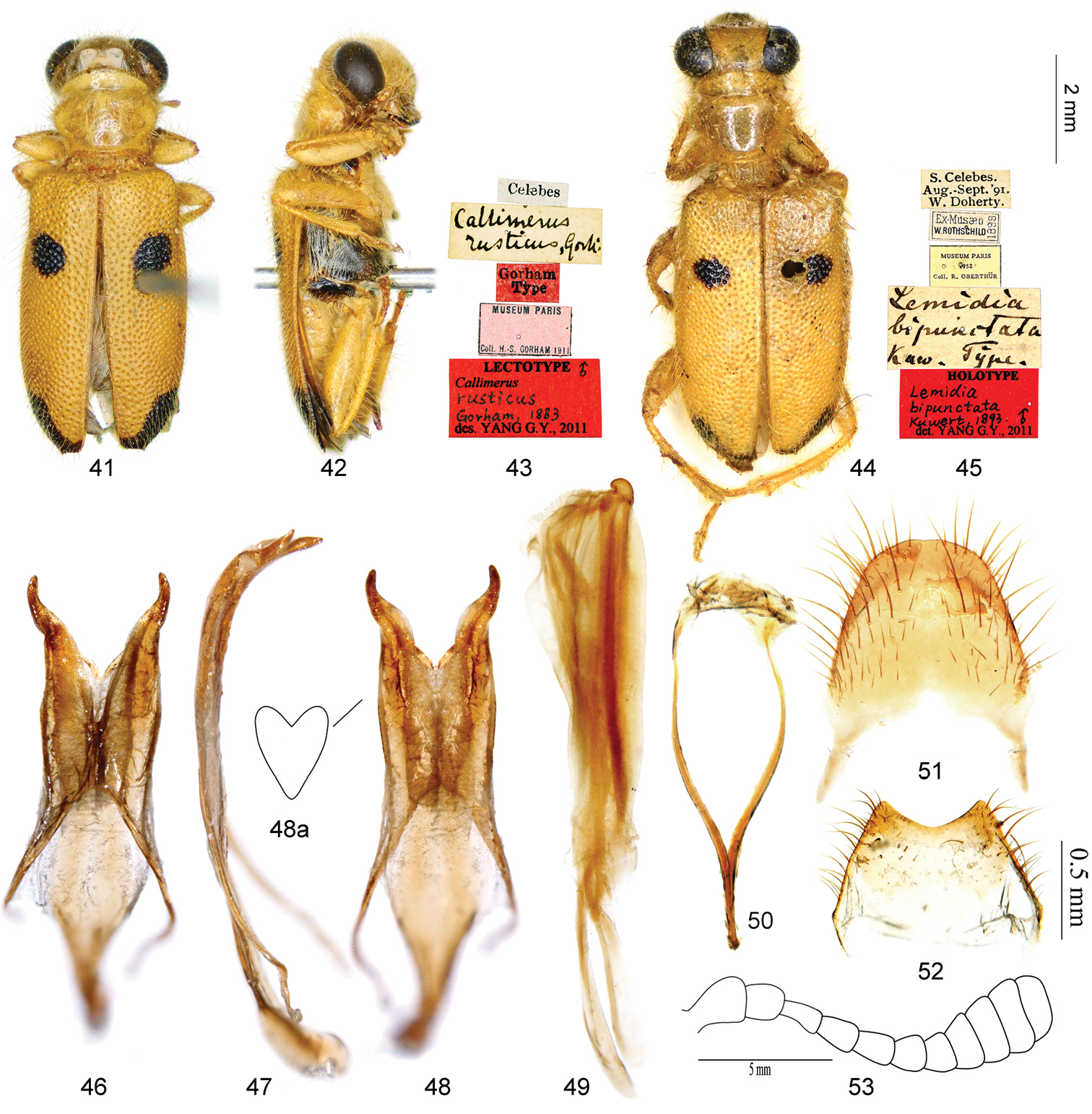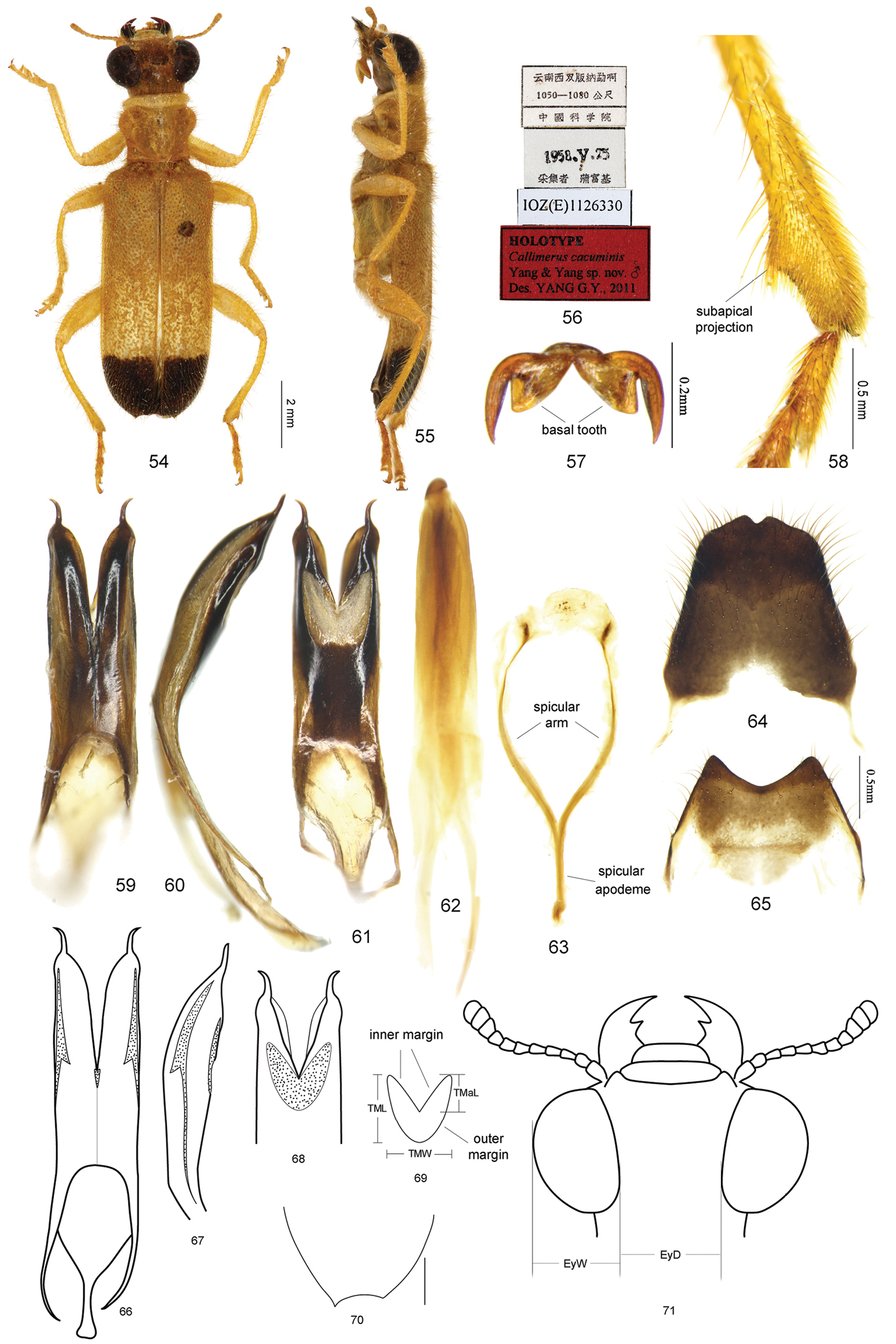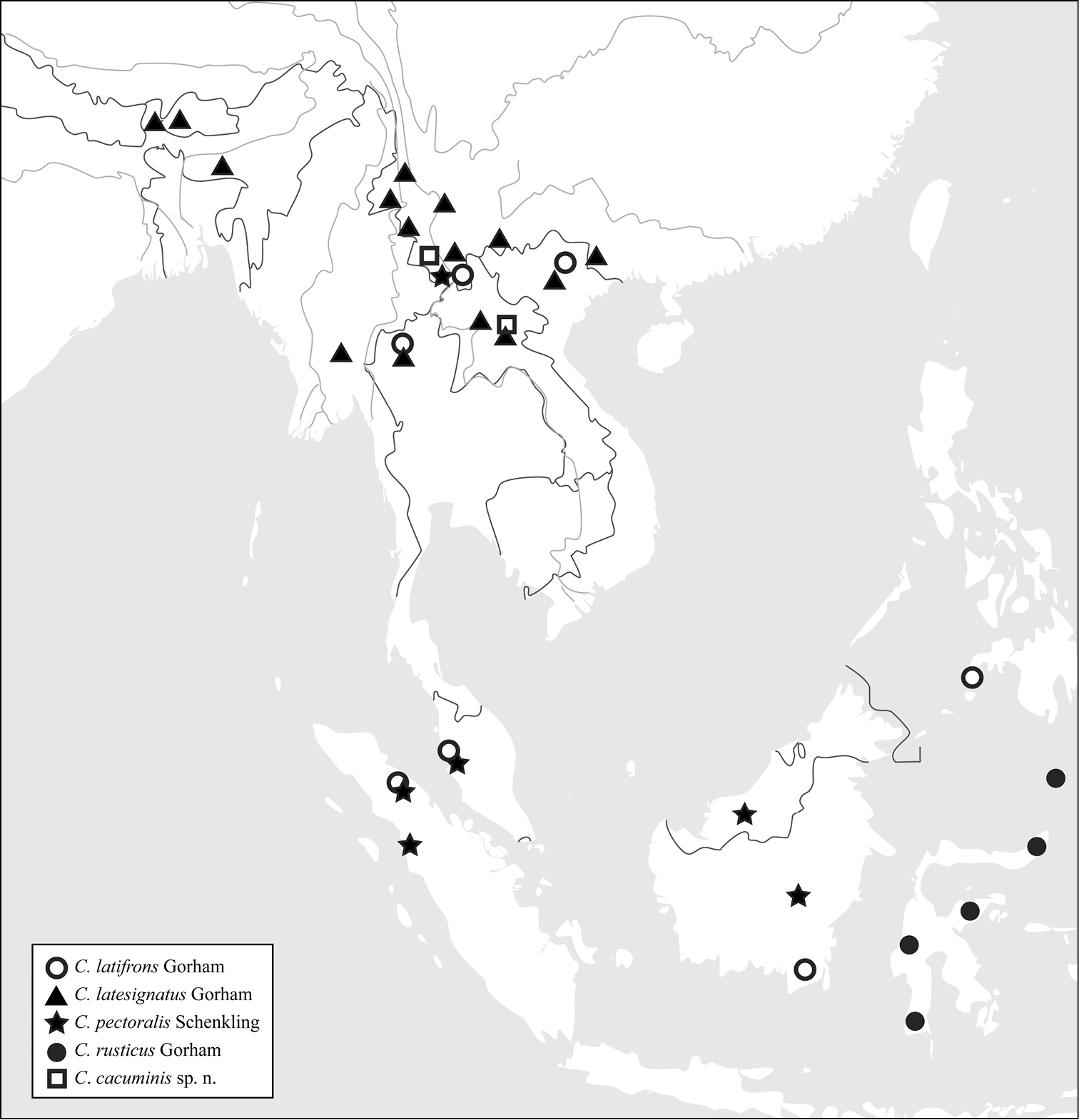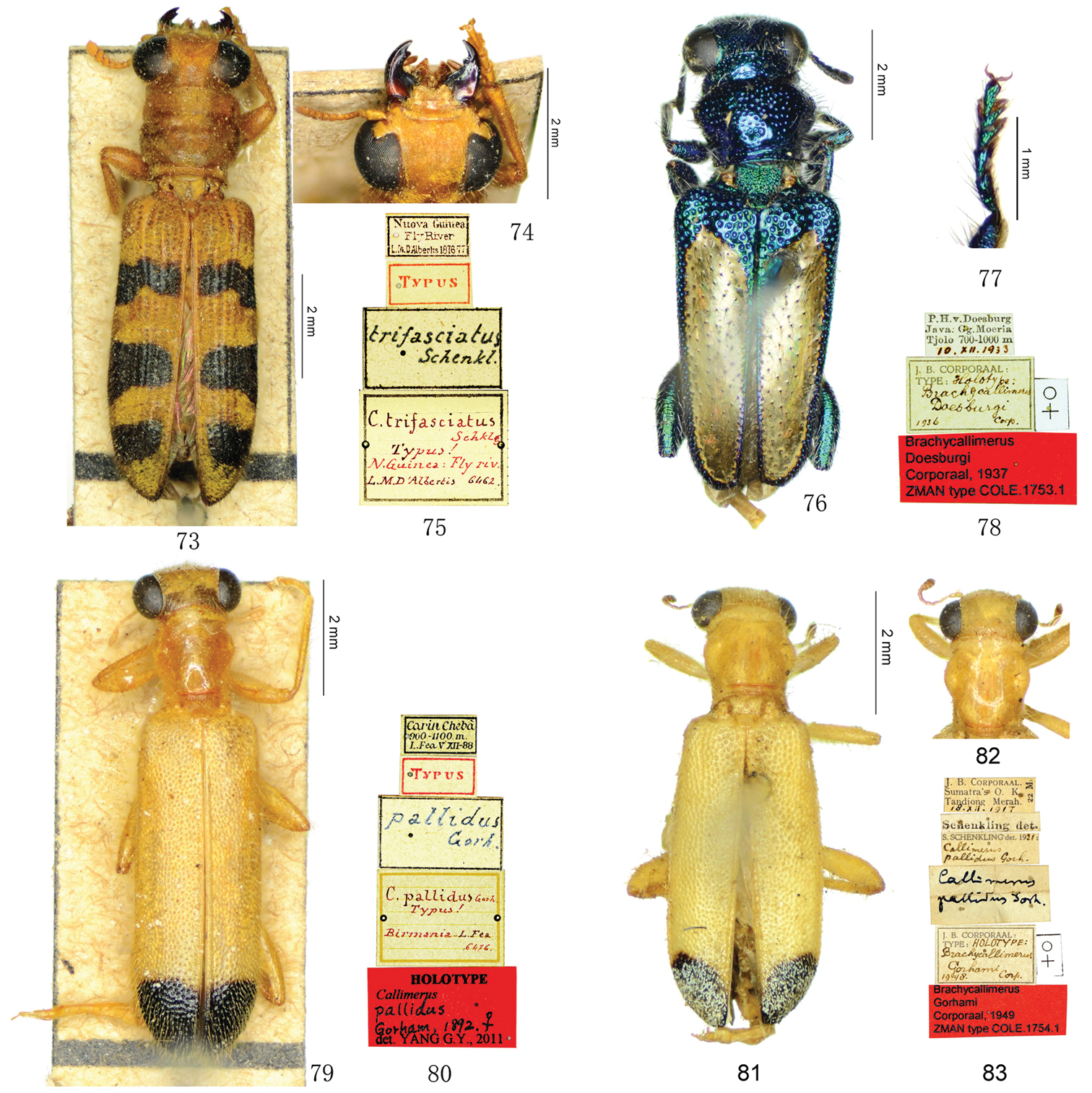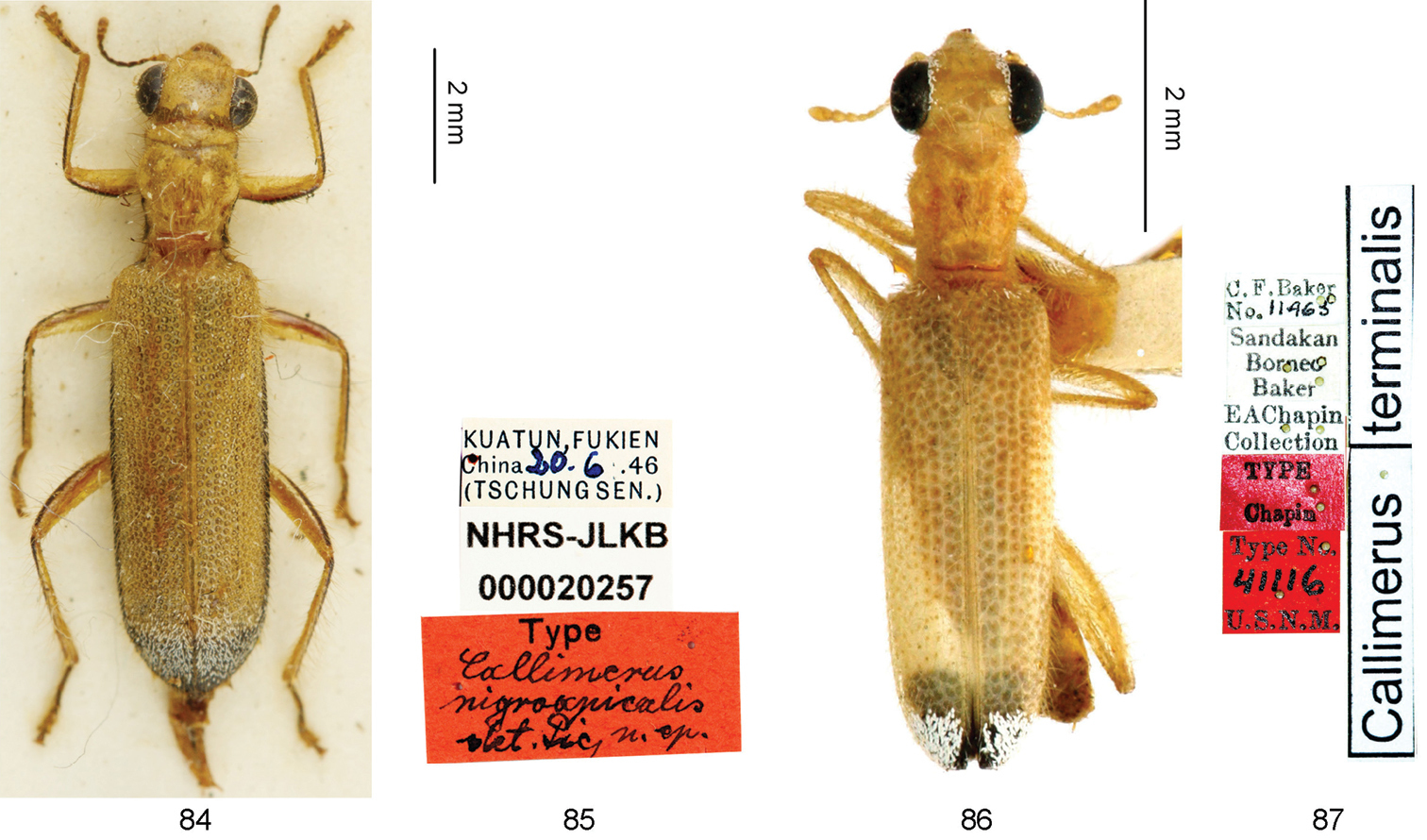






(C) 2013 Gan-Yan Yang. This is an open access article distributed under the terms of the Creative Commons Attribution License 3.0 (CC-BY), which permits unrestricted use, distribution, and reproduction in any medium, provided the original author and source are credited.
For reference, use of the paginated PDF or printed version of this article is recommended.
The latifrons species-group (=Brachycallimerus sensu Chapin 1924, Corporaal 1950; = flavofasciatus-group sensu Kolibáč 1998) of Callimerus Gorham is redefined and revised. Five species are recognized including one new species Callimerus cacuminis Yang & Yang sp. n. (type locality: Yunnan, China). Callimerus flavofasciatus Schenkling, 1902 is newly synonymized with Callimerus latifrons Gorham, 1876. Callimerus trifasciatus Schenkling, 1899a is transferred to the genus Corynommadius Schenkling, 1899a. Callimerus gorhami Corporaal, 1949 and Callimerus pallidus Gorham, 1892 are excluded from the latifrons species-group (their assignment to a species-group will be dealt with in a subsequent paper). A key to species of the latifrons species-group is given and habitus of each type specimen, male terminalia, and other diagnostic characters are illustrated.
Cleridae, Callimerus, Brachycallimerus, Oriental region, systematics, new species, synonymy, species group
The genus Brachycallimerus Chapin was erected by
In the present paper, we follow the classification system of
Materials examined in the present paper are deposited in the following collections. Abbreviations are shown in the text as follows:
CAU China Agricultural University, Beijing, China
CCCC Collection of Mr. CHEN Changchin, Taiwan, China
IZAS Institute of Zoology, Chinese Academy of Sciences, Beijing, China
MCSN Museo Civico di Storia Naturale, Genova, Italy
MNHN Muséum National d’Histoire Naturelle, Paris, France
NHMB Naturhistorisches Museum, Basel, Switzerland
NHML The Natural History Museum, London, United Kingdom
NHRS Naturhistoriska Riksmuseet, Stockholm, Sweden
OUM Hope Department of Entomology, University Museum, Oxford, United Kingdom
RMNH Rijksmuseum van Natuurlijke Historie, Leiden, The Netherlands
USNM National Museum of Natural History, Smithsonian Institution, Washington, D. C., USA
ZMAN Zoölogisch Museum Amsterdam, Leiden, The Netherlands
Whole male abdomens were removed from the body with fine forceps and treated with10% KOH solution at room temperature for 8–12 hours. Male terminalia were prised apart, rinsed and examined in 70% ethanol. Tegmina were photographed when totally dry in the air, while other parts of male terminalia were photographed in glycerol. All male terminalia components were permanentlystored within glycerol in genital vial which was pinned below specimen. Habitus images were captured using a Nikon D7000 digital camera with Tamron SP 90mm lens, or Canon 450D digital camera with CanonMacro 100 mm lens. Terminalia images were captured by a Nikon digital Sight DS–SM camera fitted to a Nikon SMZ–1500 stereoscopic dissecting microscope controlled by ACT–2U software, or by a Canon 450D digital camera fittedto a Nikon SMZ–1500 stereoscopic dissecting microscope. Series of partially focused photographswere taken and then combined using Helicon Focus software, and finallyprocessed with Adobe Photoshop software. Line drawings were made under Leica MZ125 stereoscopic dissecting microscope or created from color photographs using Adobe Illustrator software. Distribution maps, created in Adobe Illustrator software, are based on examined materials and published records.
Measurements were made under a stereomicroscope using an ocular micrometer. Body length is the linear distance from labrum to elytral apices. Body width is themaximum width across elytra. Abbreviations are shown in the text as follows: AL: antennal length; AD: distance between two antennae insertions. EyD: minimum distance between two eyes; EyW: maximum eye width in dorsal view (Fig. 71); PL: prothorax maximum length; PW: prothorax maximum width; EL: elytra maximum length; EW: elytra maximum width. Terminology mostly follows
Original and later important taxonomic references are cited after taxon names. Full label data are provided for name-bearing type specimens: label data of each specimen are enclosed within a pair of double quotation marks, and individual labels are separated by a slash. All writings are cited in their original spelling, punctuation and language. Original italic or capital is ignored. Notes and elaborations relating to label data are enclosed in square brackets (including the writer, translation, etc). Red labels have been added to holotypes, paratypes, lectotypes and paralecto- types. Full label data or, in most cases, only locality data are provided for other specimens. When transcribing the label data, “hw.” is short for “handwritten”, and ellipsis are used if the original writing were illegible and unable to be transcribed. Authors of the handwriting on determination labels are identified with the clues given by
This species group is characteristic by its broad and compact body form. It differs from dulcis species-group (sensu
It differs from coomani-group (sensu
In the integumental coloration (yellow and black), Callimerus pallidus Gorham, 1892 (Carin Hills, Chebà; Figs 79), Callimerus gorhami Corporaal, 1949 (Sumatra’s East Coast; Fig. 81), Callimerus nigroapicalis Pic, 1955 (Fujian; Fig. 84, 85), Callimerus terminalis Chapin, 1919 (Sandakan, North Borneo; Fig. 86, 87), and some species related to Callimerus insolatus Pascoe, 1860 might be similar to members of the latifrons species-group. The differences between Callimerus pallidus, Callimerus gorhami and this species group are provided in the text below. Callimerus nigroapicalis is different from this species group in pronotum longer than wide. Callimerus terminalis is different from this species group in claws without a basal tooth, subapical projection on outer edge of metatibia rudimental, pronotum longer than wide. Species related to Callimerus insolatus differ from this species group in claws without a basal tooth.
Size: length 7.5–11.7 mm, width 2.3–3.7 mm. Integumental color: yellow and black. Vestiture: body profusely vested with yellow pubescence; frons with dense white scales; thoracic pleuron sometimes with white scales. Head: including eyes wider than pronotum, vertex with sparse punctures. Labrum rectangular, apex straight or very slightly emarginated in the middle; mandibles stout; terminal segments of maxillary palpi digitiform, those of labial palpi elongate-triangular, both as long as their preceding segments. Eyes large, very slightly emarginated near antennal insertions, finely granulate; posterior inner margin of eyes evidently convergent towards midline, EyD subequal to EyW (ratio 1.0–1.1) (Figs 4, 15, 17, 28, 30, 41, 44, 54). Antenna short (AL/AD 1.0–1.2); antennomere I stout and bent, twice length as antennomere II; antennomere II globular; antennomere III longer than it is wide, slightly longer than antennomere II; antennomeres IV–X increasingly wider and shorter than their preceding segments, antennomeres VII or VIII to XI wider than or as long as their respective length, forming a more or less compact and oval club (Figs 14, 27, 40, 53, 71). Gula oblong, gular sutures parallel. Prothorax: wider than long (PL/PW 0.8–0.9), subapical impression of pronotum deep; pronotum constricted at base, evidently dilated before middle (Figs 4, 15, 17, 28, 30, 41, 44, 54); punctures on pronotum sparse and fine. Elytra: wider than head including eyes, EL/EW 1.7–2.3; sides parallel, sutural angle round, outer angle pointed (Fig. 70); punctures irregular and dense; without scales. Legs: tibiae without longitudinal ridge; metatibia with a subapical projection on outer edge (Fig. 58); tibial spur formula 0–1–1; tarsi formula 5–5–5, tarsomeres I–II evidently bilobed, III–IV more or less bilobed, V slender; tarsomere I of pro- and meso-tarsi as long as tarsomere II, meta-tarsomere I slightly longer than tarsomere II; tarsomere I–IV of all legs with evident pulvilli; claws with a basal tooth (Fig. 57). Abdomen: with six ventrites; male ventrite V–VI with posterior margin emarginated (Figs 13, 26, 39, 52, 65); female ventrite V with posterior margin straight, ventrite VI with posterior margin rounded. Male terminalia: tegmen tubular, sclerotized with three semi-transparent membranous regions: a pair of slit-like ones situated at dorsal-lateral sides (Figs 59–60, 66–67); the other one more or less cordiform, situated ventrally (Figs 60–61, 67–69). Outer margin of the ventral membranous region straight (Figs 9, 9a), slightly curved (Figs 22, 22a, 48, 48a, 61, 68, 69) or strongly curved (35, 35a); TML/TMW 0.9–1.3, TMaL/TML 0.2–0.6 (Figs 9, 9a, 22, 22a, 35, 35a, 48, 48a, 61, 68, 69). In some cases, an additional tiny membranous region presents at dorso-central side of tegmen (Fig. 66). Parameres strongly sclerotized, apices divergent (Figs 7–9, 59–61) or convergent (Figs 20–22, 33–35, 46–48). Phallic plate sclerotized in midline (Figs 10, 36, 49). Spicular fork: SApL/SFL about 0.3 (Figs 11, 24, 37, 50, 63).
Southeast Asia (Fig. 72).
This species group is probably advanced groups within Callimerus s. l., as
| 1 | Elytron with only one black spot at apex (Fig. 54); metasternum and metepisternum both yellowCallimerus cacuminis sp. n. | |
| - | Elytron with two black spots, anterior spot just before middle, posterior spot at apex or near apex (Figs 1, 15, 28, 41); metasternum and metepisternum both black | 2 |
| 2 | Head black; anterior black spot of elytron spanning from outer margin to suture or almost to suture (Figs 1, 2, 15, 17, 18) | 3 |
| - | Head yellow; anterior black spot of elytron clearly reaching neither outer margin or suture (Figs 28, 30, 31, 41, 42, 44) | 4 |
| 3 | Pronotum totally black; mesepisternum black; anterior black spot of elytron extended to suture thus forming a complete black band across elytra (Figs 1, 2); EL/EW about 2.2; apices of parameres divergent (Figs 7–9), outer margin of ventral membranous region of tegmen straight (Figs, 9, 9a)Callimerus latifrons Gorham | |
| - | Pronotum with major area yellow, only with a small transverse black patch on anterior margin (Fig. 15), in few cases such patch absent (Fig. 17); mesepisternum yellow; anterior black spot of elytron not exactly extended to suture, thus forming a incomplete black band across elytra interrupted at suture (Figs 15, 17, 18); EL/EW about 1.7; apices of paramere convergent (Figs 20–22), outer margin of ventral membranous region of tegmen slightly curved (Figs 22, 22a) | Callimerus latesignatus Gorham |
| 4 | Mesepisternum yellow; posterior black spot of elytron located vertical-apically, rounded rectangle, length to width ratio about 1.5:1 (Fig. 28); outer margin of ventral membranous region of tegmen strongly curved, TML/TMW about 0.9 (Figs 35, 35a); tergite VIII with posterior margin rounded, slightly notched in middle (Fig. 38) | Callimerus pectoralis Schenkling |
| - | Mesepisternum black; posterior black spot of elytron located lateral-apically, bar-shaped, length to width ratio about 4:1 (Fig. 41); outer margin of ventral membranous region of tegmen slightly curved, TML/TMW about 1.3 (Figs 48, 48a); tergite VIII with posterior margin almost straight (Fig. 51) | Callimerus rusticus Gorham |
http://species-id.net/wiki/Callimerus_latifrons
Figs 1–14, 72Lectotype of Callimerus latifrons Gorham designated here: “Phill. Isles / Callimerus latifrons Gorham [hw. by Gorham] / ♂ / Gorham Type / Museum Paris, Coll. H.S. Gorham 1911 / Lectotype: Callimerus latifrons Gorham, 1876 ♂, des. Yang G. Y., 2011” (MNHN, ♂; Figs 1–3); Lectotype of Callimerus flavofasciatus Schenkling designated here: “327–62 / Museum Paris; Siam; Bocourt 327-62 / Callimerus flavofasciatus Schklg. Type! [hw. by Schenkling] / Type / ♂ / Type / Lectotype ♂: Callimerus flavofasciatus Schenkling, 1902, des. Yang G. Y., 2011” (MNHN, ♂; Figs 4–6).
The name-bearing types of latifrons and flavofasciatus were not fixed in the original publications, so lectotypes of both species are designated here to express the taxonomic purpose of fixing the name to a single specimen and preventing further uncertainty regarding the taxon to which the names are applied. Only one specimen of each species was found in related museums.
Callimerus latifrons can be rapidly distinguished from other species of this species group by its entirely black pronotum (Figs 1, 2).
There are 3 other species of this species group with two black spots on each elytron: Callimerus latesignatus, Callimerus pectoralis and Callimerus rusticus. In addition to the difference in pronotal coloration, Callimerus latifrons can be differentiated from these three species by: (1) EL/EW about 2.2 (in other 3 species 1.7–1.8); (2) anterior black spot of elytron spanning from elytral outer margin to suture, thus forming a complete black band across elytra (Fig. 1); (3) apices of paramere divergent (Fig. 7–9).
Size:length 7.5–8.9 mm, width 2.3–2.8 mm. Color: Head black, clypeus, labrum, palpi and antennae yellow; pronotum black; elytron yellow with two black spots, anterior spot just before middle, posterior spot near apex or at apex, both spots spanning from elytral outer margin to suture, thus forming two complete black bands across elytra; legs yellow with metacoxae black; prosternum black; mesepisternum black, mesepimeron yellow, mesosternum black with anterior and posterior areas more or less yellowish; metepisternum, metasternum and katepisternum black; abdominal ventrites I–III of male yellow, IV–VI black; abdominal ventrites I–V of female yellow, VI black. Vestiture: meso- and meta- pleuron more or less with thin white scales. Head: AL/AD about 1.0; EyD/EyWabout 1.0. Prothorax: PL/PW about 0.9. Elytra: EL/EW about 2.2. Male terminalia: apices of paramere divergent (Figs 7–9); TML/TMW about 1.2, TMaL/TML about 0.4, outer margin of ventral membranous region straight (Figs 9, 9a); SApL/SFL about 0.3 (Fig. 11); tergite VIII with posterior margin rounded and slightly pointed (Fig. 12); sternite VIII with posterior margin roundly concave (Fig. 13).
Variation. The posterior black spot on elytron in most cases doesn’t reach to the extreme apex and thus a small region of elytron extreme apex is yellow. But in a few specimens the black spot reach to the extreme apex, so the yellow portion is missing. These two color forms could be found in the same locality (Yunnan, China for instance) and they are not correlated with sex.
Other material examined. China: Yunnan: Xishuangbanna Damenglong, 650 m, 1958.IV.9, WANG Shuyong, IOZ(E)1126312 (IZAS, 1♂); same data but 1958.V.5, PU Fuji, IOZ(E)1126311 (IZAS, 1♀); Xishuangbanna, Yunjinghong, 650 m, 1959.V.5, ZHANG Xuezhong, IOZ(E)1126310 (IZAS, 1♂); Xishuangbanna, Mengla, 620–650 m, 1959.V.13, PU Fuji, IOZ(E)1126319 (IZAS, 1♀); Xishuangbanna, Xiaomengyang, 850 m, 1958.VIII.18, ZHANG Yiran, IOZ(E)1126309 (IZAS, 1♀); same data but 1957.VI.10, WANG Shuyong, IOZ(E)1126306 (IZAS, 1♂); Jinping, Mengla, 420 m, 1956.IV.19, HUANG Keren et. al., IOZ(E)1126283 (IZAS, 1♀); Jinping, Mengla, 420 m, 1956.IV.27, HUANG Keren et. al., IOZ(E)1126284 (IZAS, 1♂); Jinping, Mengla, 370 m, 1956.IV.12, HUANG Keren et. al., IOZ(E)1126287 (IZAS, 1♂); Vietnam: Tonkin, Backan; Lemée, 1908; Musum Paris 1952, Coll. R. Oberthür (MNHN, 1♀); Thailand: nr. Chiangdao cave, 800 m, N. Thailand, 19-IV-1983, T. Shimomura leg. (MNHN, 1♀); Philippines: “L. Laglaize 1879; Dumalon Zamboanga; Mindanao / Callimerus latifrons Gorh., det. Corporaal 1923 / Musum Paris 1952, Coll. R. Oberthür / ♂” (MNHN, 1♂)*; Malaysia: “Doherty / Perak / Fry Coll. 1905. 100 / C. latifrons G. [hw. by Gorham] / Callimerus latifrons Gorham, Gorham det. [hw. by Gahan]” (NHML, 1♀); Indonesia: “J.B. Corporaal; Sumatra’s O. K. Medan, 24.12.1917; 20 M / Musum Paris 1952, Coll. R. Oberthür / ♂” (MNHN, 1♂); “J.B. Corporaal; Sumatra’s O. K. Medan, 24.12.1917; 20 M / Callimerus flavofasciatus Schenkling; Corporaal det. 1923 / Musum Paris 1952, Coll. R. Oberthür / ♂” (MNHN, 1♂); “J.B. Corporaal; Sumatra’s O. K. Medan, 24.12.1917; 20 M / Callimerus flavofasciatus Schl. / [...] / [...] / Corporaal det. 1923 / Musum Paris 1952, Coll. R. Oberthür / ♀” (MNHN, 1♀); “J.B. Corporaal; Sumatra’s O. K. Pagar Marbau, 15 / 12.’18; 24 M / J.B. Corporaal det. 1922: Callimerus flavofasciatus Schl. / Musum Paris 1952, Coll. R. Oberthür / ♂” (MNHN, 1♂); “J.B. Corporaal; Sumatra’s O. K. Pagar Marbau, 15 / 12.’18; 24 M / B. flavofasciatus Schl. / Musum Paris, Coll. M. Pic / ♂” (MNHN, 1♂); “J.B. Corporaal; Sumatra’s O. K. Medan, 1.11.[19]21; 20 M / J.B. Corporaal det. 1922: Callimerus flavofasciatus Schl. / Musum Paris 1952, Coll. R. Oberthür / ♂” (MNHN, 1♂); “J.B. Corporaal; Sumatra’s O. K. Medan, 6.1921; 20 M / 1938 J.B. Corporaal det: Brachycallimerus latifrons Gorh. var. flavofasciatus Schenkl. / Musum Paris 1939, Corporaal / ♂” (MNHN, 1♂); “J.B. Corporaal; Sumatra’s O. K. Medan, 22.1.[19]21; 20 M / 1938 J.B. Corporaal det: Brachycallimerus latifrons Gorh. var. flavofasciatus Schenkl. / Musum Paris, Coll. M. Pic / ♂” (MNHN, 1♂); “J.B. Corporaal; Sumatra’s O. K. Pagar Marbau, 15 / 12.’18; 24 M / Musum Paris 1952, Coll. R. Oberthür / ♀” (MNHN, 1♀); “J.B. Corporaal; Sumatra’s O. K. Pagar Marbau, 15 / 12.’18[1918]; 24 M / [...1] / Brachycallimerus flavofasciatus Schl. / Musum Paris, Coll. M. Pic / ♀” (MNHN, 1♀); “Sumatra, Si-Rambe, XII.90-III.91, E. Modigliani / 1941 Corporaal det. Brachycallimerus latifrons Gorh. var. flavofasciatus Schenkling” (MCSN, 1♀); “59192 / Doherty / Borneo, Pengaron / Fry Coll. 1905. 100 / C. latifrons G. [hw. by Gorham] / Callimerus latifrons Gorham, Borneo, Perak” (NHML, 1♀).
(Fig. 72). China (Yunnan), Vietnam, Thailand, Philippines (Mindanao), Malaysia, Indonesia (Sumatra, Borneo).
Callimerus latifrons Gorham, 1876. 1–3 lectotype of Callimerus latifrons Gorham, 1876 (1 dorsal view 2 mirror image of right lateral view 3 labels) 4–6 lectotype of Callimerus flavofasciatus Schenkling, 1902 (4 dorsal view 5 lateral view 6 labels) 7–13 male terminalia, specimen from Philippines 7–9 tegmen (7 dorsal view 8 lateral view 9 ventral view 9a outline of ventral membranous region) 10 phallus 11 spicular fork 12 tergite VIII 13 sternite VIII 14 antenna, specimen from Yunnan.
http://species-id.net/wiki/Callimerus_latesignatus
Figs 15–27, 72Lectotype of Callimerus latesignatus Gorham designated here:“Carin Chebà, 900–1000 m; L. Fea, V XII-88 / Typus / latesignatus Gorh. [hw. by Raffaello Gestro]/ Lectotype: Callimerus latesignatus Gorham, 1892, des. Yang G. Y., 2011” (MCSN, sex unknown; Figs 15–16); Paralectotypes of Callimerus latesignatus Gorham: “Carin Chebà, 900–1000 m; L. Fea, V XII-88 / Callim. late-signatus Gorh. typus! [hw. by Raffaello Gestro] / Type / Museo Civ. Genova / Museum Paris, Coll. H.S. Gorham, 1911 / Paralectotype ♀, Callimerus latesignatus Gorham, 1892, des. Yang G. Y., 2011” (MNHN, 1♀; Figs 17–19); “Doherty / Assam, Nagas / Fry Coll. 1905. 100. / C. latesignatus Gorh. [hw. by Gorham] / Callimerus latesignatus Gorham; Gorham det. [hw. by Gahan]” (NHML, 1 ex., sex unknown); “62022 / Doherty / Assam, Nagas / Fry Coll. 1905. 100. / Callimerus latesignatus Gorh., Assam, Type [“Type” with strikethrough; hw. by Frey]” (NHML, 1 ex., sex unknown).
The name-bearing type of Callimerus latesignatus was not fixed in the original publication so the lectotype is designated here to express the taxonomic purpose of fixing the name to a single specimen and preventing further uncertainty regarding the taxon to which the name is applied. The specimen deposited in MCSN is chosen as the lectotype because the type series were originally from that museum’s expedition.
Callimerus latesignatus is most similar to Callimerus latifrons and Callimerus pectoralis. It differs from Callimerus latifrons by: (1) pronotum with major area yellow, only with a small transverse black patch on anterior margin (Fig. 15), in few cases such patch absent (Fig. 17) (pronotum totally black in Callimerus latifrons); (2) mesepisternum yellow (black in Callimerus latifrons); (3) anterior black spot of elytron not exactly extended to suture, thus forming a incomplete black band across elytra interrupted at suture (Figs 15, 17, 18) (anterior black spot of elytron extended to suture in Callimerus latifrons, thus forming a complete black band across elytra; Figs 1, 2); (4) EL/EW about 1.7 (Callimerus latifrons with EL/EW about 2.2); (5) apices of paramere convergent (Figs 20–22) (Callimerus latifrons with apices of paramere divergent; Figs 7–9); (6) outer margin of ventral membranous region of tegmen slightly curved, TMaL/TML about 0.6 (Figs 22, 22a) (Callimerus latifrons with outer margin of ventral membranous region of tegmen straight, TMaL/TML about 0.4; Figs 9, 9a).
Callimerus latesignatus differs from Callimerus pectoralis by: (1) head black (Callimerus pectoralis with head yellow); (2) pronotum with major area yellow, only with a small transverse black patch on anterior margin (Fig. 15), in few cases such patch absent (Fig. 17)(Callimerus pectoralis with pronotum always totally yellow); (3) mesepisternum yellow (black in Callimerus pectoralis); (4) anterior spot of elytron spanning from elytral outer margin to nearly suture (Figs 15, 17, 18) (Callimerus pectoralis with anterior spot of elytron clearly neither reaching outer margin nor suture, such spot smaller; Figs 28, 30, 31); (5) outer margin of ventral membranous region of tegmen slightly curved, TMaL/TML about 0.6 (Figs 22, 22a) (Callimerus pectoralis with outer margin of ventral membranous region of tegmen strongly curved; TMaL/TML about 0.3; Figs 35, 35a); (6) tergite VIII with posterior margin almost straight (Fig. 25) (tergite VIII of Callimerus pectoralis with posterior margin notched in the middle; Fig. 38).
Size:length 8.2–10.5 mm, width 2.8–3.8 mm. Color: Head black, clypeus, labrum, palpi and antennae yellow; pronotum with major area yellow, only with a small transverse black patch on anterior margin (Fig. 15), in a few cases such patch absent (Fig. 17); elytron yellow with two black spots, anterior spot just before middle, posterior spot near apex, both spots spanning from elytral outer margin almost to suture, thus forming two incomplete bands across elytra interrupted at the suture; legs yellow with metacoxae mostly black; prosternum, mesepisternum, mesepimeron and mesosternum yellow; metepisternum, metasternum and katepisternum black; abdominal ventrites usually yellow, in a few cases terminal ventrite darker. Head: AL/AD about 1.0; EyD/EyWabout 1.0. Prothorax: PL/PW about 0.8. Elytra: EL/EW about 1.7. Male terminalia: apices of parameres convergent (Figs 20–22); TML/TMW about 0.9, TMaL/TML about 0.6, outer margin of ventral membranous region slightly curved (Figs 22, 22a); SApL/SFL about 0.3 (Fig. 24); tergite VIII with posterior margin almost straight (Fig. 25); sternite VIII with posterior margin shallowly triangularly concave (Fig. 26).
Variation. The pronotum of most specimens is yellow with a small transverse black patch on anterior margin, but two females examined don’t have such a patch and thus the pronotum is totally yellow (one of which is the paralectotype in MNHN).
China: Guangxi: Daqingshan, Hengle, light trap, 1983.V.7, LIAO Subai (IZAS, 1♀); Pingxiang, YANG Jikun, 1963.V.10 (CAU, 3 ex.); same data but 1963.V.12 (CAU, 1 ex.); Yunnan: Mangshi, 900 m, 1955.V.16, Bustshik, IOZ(E)1126291 (IZAS, 1♂)*; Mangshi, 900 m, 1955.V.16, Kryzhanovskij, IOZ(E)1126292 (IZAS, 1♂); Mangshi, 900 m, 1955.V.16, Kryzhanovskij, IOZ(E)1126293 (IZAS, 1♀); Mangshi, 920 m, 1958.IX.1, LI Chuanlong, IOZ(E)1126325 (IZAS, 1♀); Gengma, 1955.V.2, HUANG Tianrong, IOZ(E)1126295 (IZAS, 1♀); eshan, 80.8, IOZ(E)1126959 (IZAS, 1♀); Baoshan, Diyidaoban, 1200 m, 1955.V.28, OU Bingrong, IOZ(E)1126305 (IZAS, 1♂); Baoshan to Yongping, 1955.V.28, B. Popov, IOZ(E)1126297 (IZAS, 1♀); Jingdong, Waidaba, 1250 m, 1956.V.26, YANG Xingchi, IOZ(E)1126289 (IZAS, 1♀); Jingdong, 1170 m, 1956.V.22, B. Popov, IOZ(E)1126300 (IZAS, 1♂); Jingdong, 1170 m, 1956.V.23, Kryzhanovskij, IOZ(E)1126301 (IZAS, 1♀); Jingdong, 1170 m, 1956.V.26, Kryzhanovskij, IOZ(E)1126302 (IZAS, 1 ex.); Jingdong, , 1200 m, 1955.IV.27, Kryzhanovskij, IOZ(E)1126303 (IZAS, 1 ex.); Jinping, Mengla, 420 m, 1956.IV.19, HUANG Keren et. al., IOZ(E)1126282 (IZAS, 1 ex.); Jinping, Mengla, 400 m, 1956.IV.27, HUANG Keren et. al., IOZ(E)1126285; IOZ(E)1126286 (IZAS, 2 ex.); Jinping, Mengla, 370 m, 1956.IV.22, HUANG Keren et. al., IOZ(E)1126288 (IZAS, 1 ex.); Cheli, Shihuiyao, 750 m, 1957.IV.27, D. Panfilov, IOZ(E)1126296 (IZAS, 1 ex.); Damenglong, 640 m, 1957.IV.28, WANG Shuyong, IOZ(E)1126304 (IZAS, 1 ex.); Xishuangbanna, Xiaomengyang, 850 m, 1957.VI.25, ZANG Lingchao, IOZ(E)1126307 (IZAS, 1 ex.); same data but 1957.III.28, ZANG Lingchao, IOZ(E)1126294 (IZAS, 1 ex.); same data but 1958.IX.7, ZHANG Yiran, IOZ(E)1126308 (IZAS, 1 ex.); same data but 1957.IV.2, WANG Shuyong, IOZ(E)1126290 (IZAS, 1 ex.); same data but 1000 m, 1957.V.6, ZANG Lingchao, IOZ(E)1126298 (IZAS, 1 ex.); Xishuangbanna, Meng’a, 1050–1080 m, 1958.V.16, IOZ(E)1126323 (IZAS, 1 ex.); same data but 1958.V.25, PU Fuji, IOZ(E)1126314 (IZAS, 1 ex.); same data but 1958.V.12, IOZ(E)1126324 (IZAS, 1 ex.); same data but 1050 m, 1958.V.20 IOZ(E)1126313 (IZAS, 1 ex.); Xishuangbanna, Mengzhe, 870 m, 1958.VII.7, PU Fuji, IOZ(E)1126315 (IZAS, 1 ex.); Xishuangbanna, Mengzhe, 870 m, 1958.IX.3, WANG Shuyong, IOZ(E)1126316 (IZAS, 1 ex.); Xishuangbanna, Mengla, 620–650 m, 1959.V.13, ZHANG Facai, IOZ(E)1126317 (IZAS, 1 ex.); same data but 1959.V.2, ZHANG Yiran, IOZ(E)1126318 (IZAS, 1 ex.); same data but 1959.VI.6, PU Fuji, IOZ(E)1126320 (IZAS, 1 ex.); same data but 1959.VI.6, ZHANG Yiran, IOZ(E)1126321 (IZAS, 1 ex.); same data but 1959.V.3, ZHANG Yiran, IOZ(E)1126322 (IZAS, 1 ex.); Hekou, Nanxi, Huayudong, 150 m, 2010.IV.27, ZHU Xiaoyu leg., under surface of leaves of Ficus (CCCC, 4 ex.); Honghe, Hekou, Nanxi, 150 m, 2009.V.21, LI Hu leg. (CAU, 1♀); Vietnam: “Museum Paris; Tonkin sept., Montagnes du Haut Song-Chai, Rabier 1895 / Museum Paris; Mes du Ht Song-Chai; Rabier 258-95 / Callimerus latesignatus Gorh., Schenkling vid. 1901” (MNHN, 1♂); “Museum Paris; Tonkin; Langue 1887 / Callimerus latesignatus Gorh., Schenkling vid 1901 / Compare au British Museum; P. Lesne 1907 / Callimerus latesignatus Gorh., P. Lesne vid.” (MNHN, 1♂); Tonkin occ., Env. de Hoa-Binh, R.P A. de Cooman 1919 (MNHN, 4 ex.); Tonkin, P. Lemée, 1903–1906 (MNHN, 3 ex.); Laos: Louang-Prabang, A Theng; A. Pavie 1888 (MNHN, 1 ex.); Laos (MNHN, 1 ex.); “Laos-NE, Xieng Khouang prov., 19°38'N, 103°20'E-19°37'N, 103°21'E, 30km NE Phonsavan: Ban Na Lam→Phou Sane Mt., 1300–1700 m, 10.-30.v.2009, M. Geiser leg. / NHMB Basel, NMPC Prague, Laos 2009 Expedition: M. Brancucci, M. Geiser, Z. Kraus, D. Hauck, V. Kuban” (NHMB, 1 ex.); “Laos-NE, Xieng Khouang prov., ~19°37–8'N 103°20'E, Phonsavan (30 km NE): Phou Sane Mt., ~1400–1500 m, 10.-30.v.2009, Z. Kraus leg. / NHMB Basel, NMPC Prague, Laos 2009 Expedition: M. Brancucci, M. Geiser, Z. Kraus, D. Hauck, V. Kuban” (NHMB, 1 ex.); Thailand: Siam, Lot 319, 3300 feet, 21 Jun 1936 (MNHN, 1 ex.); “Doi Suthep, 1100 m, Chiang Mai, N. Thailand, 15-IV-1983, T. Shimomura leg.” (MNHN, 1 ex.); “Mt. Doi Pui, 1400–1500 m, Chiang Mai, N. Thailand, 28-IV-1983, T. Shimomura leg.” (MNHN, 1 ex.); India: “Village 9th mile, nt. Rani Pul, 24.4 / Sikkim 77, Bhakta B.” (NHMB, 2 ex.); Khasia Hills, VI. 96 (MNHN, 1 ex.); “Mali 900 m, 28.4.1981 / Sikkim, Bhakta B.” (NHMB, 1 ex.); “Tista, 18.IV.1987 / Indien, Darjeeling D., Bhakta B.” (NHMB, 1 ex.); “Pudung, 24–25.V.87 / Indien, Darjeeling D., Bhakta B.” (NHMB, 1 ex.); “Pudung, 18.IV.1990 / Indien, Darjeeling D., Ch. J. Rai” (NHMB, 1 ex.); “Alghera, 2900 m, 25.IV.1982 / Darjeeling D., Ch. J. Rai” (NHMB, 1 ex.); “Umg. Kalimpong, Darjeeling Distr., 4.4.77” (NHMB, 1 ex.); “Kalimpong, Umg, Bhakta Bahadur, 10.5.77” (NHMB, 3 ex.); “Kalimpong 850 m, Nashay, 16.IV.1984 / Indien, Darjeeling D., Ch. J. Rai” (NHMB, 1 ex.); “Pudung, 24–25.V.87 / Indien, Darjeeling D., Bhakta B.” (NHMB, 1 ex.); Bhutan: British Bootang, L. Durel, 1899 (MNHN, 2 ex.); British Bootang, Maria Basti, 1900 (MNHN, 1 ex.); British Bootang, Maria Basti, 1899 (MNHN, 1 ex.); British Bootang, Padong, L. Durel 1913 (MNHN, 1 ex.); Pedong, A. Desgodins (MNHN, 2 ex.).
(Fig. 72). China (Guangxi, Yunnan), Vietnam, Laos, Thailand, Myanmar, India, Bhutan.
Callimerus latesignatus Gorham, 1892. 15–16 lectotype of Callimerus latesignatus Gorham, 1892 (15 dorsal view 16 labels) 17–19 Paralectotype of Callimerus latesignatus Gorham, 1892 from MNHN (17 dorsal view 18 lateral view 19 labels) 20–26 male terminalia, specimen from Yunnan 20–22 tegmen (20 dorsal view 21 lateral view 22 ventral view 22a outline of ventral membranous region) 23 phallus 24 spicular fork 25 tergite VIII 26 sternite VIII 27 antenna, specimen from Yunnan.
http://species-id.net/wiki/Callimerus_pectoralis
Figs 28–40, 72Lectotype of Callimerus pectoralis Schenkling designated here: “Sumatra / Padang, 1890, E. Modigliani / Teste Schenkling / C. quadripunctatus Schklg, Sumatra, E. Modigliani, 6478 [hw. by Raffaello Gestro]/ Lectotype ♀: Callimerus pectoralis Schenkling, 1899, des. Yang G. Y, 2011” (MCSN, ♀; Figs 28–29).
The lectotype is one of the specimens sent to S. Schenkling for study from MCSN, with a label “quadripunctatus Schklg” handwritten by R. Gestro, the former curator of MCSN. The name “quadripunctatus Schklg” has never been published, however, the locality and morphological characters of this specimen perfectly accord with the original publication of Callimerus pectoralis. On the other hand, a specimen found in Coll. M. Pic from MNHN (locality Medan, Sumatra) determined as Callimerus pectoralis by Schenkling himself is conspecific with the specimen labeled “quadripunctatus Schklg” (Figs 30–32). In this case, it is assumed that “quadripunctatus” was the first name that came to Schenkling’s mind and written down in the identification list that sent to MCSN, but later Schenkling changed his mind and published the species with another name “pectoralis”. Regardless of the details, the specimen found in MCSN undoubtedly belongs to the type series and we therefore designated it as the lectotype of Callimerus pectoralis Schenkling here for the taxonomic purpose of fixing the name to a single specimen and preventing further uncertainty regarding the taxon to which the name is applied.
This species is most similar to Callimerus rusticus and Callimerus latesignatus. However, it differs from Callimerus rusticus by: (1) mesepisternum yellow (black in Callimerus rusticus); (2) posterior spot on elytron located vertical-apically, rounded rectangle, length to width ratio about 1.5:1 (Fig. 28)(Callimerus rusticus with posterior spot on elytron located lateral-apically, bar-shaped, length to width ratio about 4:1; Fig. 41); (3) anterior spot on elytron of Callimerus pectoralis larger than that of Callimerus rusticus, in Callimerus pectoralis short diameter of anterior spot on elytron in most cases larger than distance between that spot and elytral suture (Fig. 28, 30) (Callimerus rusticus short diameter of anterior spot on elytron in most cases not larger than distance between that spot and elytral suture; Fig. 41, 44); (4) outer margin of ventral membranous region of tegmen strongly curved, TML/TMW about 0.9, TMaL/TML about 0.3 (Figs 35, 35a) (Callimerus rusticus with outer margin of ventral membranous region of tegmen slightly curved, TML/TMW about 1.3, TMaL/TML about 0.2; Figs 48, 48a); (5) tergite VIII with posterior margin rounded, slightly notched in middle (Fig. 38) (Callimerus rusticus with tergite VIII with posterior margin almost straight; Fig. 51).
The difference between this species and Callimerus latesignatus is provided in the diagnosis section under Callimerus latesignatus.
Size:length 7.5–8.8 mm, width 2.8–3.3 mm. Color: Head yellow, mandibles black; pronotum yellow. Elytron yellow with two spots, anterior spot at basal one fourth, posterior spot at vertical-apex; anterior spot rounded rectangle, neither reaching outer margin nor suture, short diameter of anterior spot on elytron in most cases greater than distance between that spot and elytral suture (Fig. 28, 30); posterior spot rounded rectangle, length to width ratio about 1.5:1 (Fig. 28, 30). Legs yellow with metacoxae mostly black. Prosternum, mesepisternum, mesepimeron and mesosternum yellow; metepisternum, metasternum and katepisternum black; abdominal ventrites yellow. Head: AL/AD about 1.0; EyD/EyW about 1.0. Prothorax: PL/PW about 0.8. Elytra: EL/EW about 1.7. Male terminalia: apices of parameres convergent (Figs 33–35); TML/TMW about 0.9; TMaL/TML about 0.3, outer margin of ventral membranous region strongly curved (Figs 35, 35a); SApL/SFL about 0.3 (Fig. 37); tergite VIII with posterior margin rounded, slightly notched in middle (Fig. 38); sternite VIII with posterior margin roundly concave (Fig. 39).
China: Yunnan: Xishuangbanna, Damenglong, 650 m, 1958.IX.17, PU Fuji leg., IOZ (E)1126329 (IZAS, 1♂); Malaysia: Perak, Doherty (MNHN, 1 ex.; NHML, 5 ex.); Malacca, Perak, W. Doherty (MNHN, 1 ex.); Perak, Malacca (Doherty) (MNHN, 1 ex.); “Penang / Bowring 63.47* / Callimerus pectoralis Scklg, S. Schenkling det.” (NHML, 2); “Penang / Ex. A. R. Wallace, Private collection, Purchased 1860–70, Ox. Uni. Mus. of Nat. Hist. (OUMNH)” (OUM, 4 ex.); Kuching, Sarawak, G.E. Bryant, 28.XI.13 (NHML, 1 ex.); Indonesia: J.B. Corporaal; Sumatra’s O. K., Medan, 1.11.20, 20 M (MNHN, 1♂)*; same data but 20.2.18 (MNHN, 1 ex.); same data but 8.2.21 (MNHN, 1 ex.); same data but 9.8.1921 (MNHN, 3 ex.); same data but 11.8.1921 (MNHN, 1); same data but 18.8.1921 (MNHN, 1 ex.); same data but 10.9.1921 (MNHN, 1 ex.); “Corporaal, Medan, 30.10.17 / Corporaal comment / Museum Paris, Coll. M. Pic / Callimerus pectoralis Schklg [hw. by Schenkling]” (MNHN, 1♂); Sumatra, Padang Sidempoean, XII.1902-I.1903 (MNHN, 2 ex.); “Dolok Merangir, 18.VII-9.X.1980 / Sumatra, Dr. E. Diehl” (NHMB, 2 ex.); “42618 / Borneo, Labuan / Fry Coll. 1905. 100 / C. rusticus G. [hw. by Gorham] / Callimerus rusticus Gorham, det. Borneo, Perak [hw. by Fry]” (NHML, 1 ex.); Sud Borneo, Goenong Pandjang, Tanggarang, M. E.Walsh, VI.1937 (MNHN, 1 ex.).
(Fig. 72). China (Yunnan), Malaysia, Indonesia (Sumatra, Borneo).
Callimerus pectoralis Schenkling, 1899. 28–29 lectotype of Callimerus pectoralis Schenkling, 1899 (28 dorsal view 29 labels) 30–32 a specimen determined by Schenkling as Callimerus pectoralis (30 dorsal view 31 lateral view 32 labels) 33–39 male terminalia, specimen from Sumatra 33–35 tegmen (33 dorsal view 34 lateral view 35 ventral view 35a outline of ventral membranous region) 36 phallus 37 spicular fork 38 tergite VIII 39 sternite VIII 40 antennae, specimen from Yunnan.
http://species-id.net/wiki/Callimerus_rusticus
Figs 41–53, 72Lectotype ofCallimerus rusticus Gorham designated here: “Celebes / Callimerus rusticus, Gorh. / Gorham Type / Museum Paris, Coll. H. S. Gorham, 1911/ Lectotype ♂: Callimerus rusticus Gorham, 1883, des. Yang G. Y., 2011” (MNHN, ♂; Figs 41–43); Paralectotype ofCallimerus rusticus: “Rosenb., Sangir / Callimerus rusticus Gorham / Type ♀ / Type / rusticus Gorh. n. sp.” (RMNH, 1♀); Holotype of Lemidia bipunctatus Kuwert: “S. Celebes, Aug.-Sept. ‘91, W. Doherty / Ex-Musaeo, W. Rothschild, 1899 / Museum Paris, 1952, Coll. R. Oberthür / Lemidia bipunctata Kuw. Type / Holotype: Lemidia bipunctata Kuwert, 1893, ♂, det. Yang G. Y., 2011” (MNHN, ♂; Figs 44–45).
The original description of Callimerus rusticus Gorham mentioned two specimens, but the name-bearing type was not fixed. We found both syntypes in MNHN and RMNH respectively, and designate the male from Coll. Gorham in MNHN as lectotype here to express the taxonomic purpose of fixing the name to a single specimen and preventing further uncertainty regarding the taxon to which the name is applied.
The original publication of Lemidia bipunctatus Kuwert noted that only one specimen was examined, so the holotype was originally fixed by monotypy.
This species can be rapidly distinguished from other species of the latifrons species-group by posterior spot on elytron being located lateral-apically, bar-shaped, with a length to width ratio of about 4:1 (Fig. 41).
This species is most similar to Callimerus pectoralis; the difference between them is provided in the diagnosis section under Callimerus pectoralis.
Size:length 7.5–9.5 mm, width 2.4–3.0 mm. Color: Head yellow, mandibles black; pronotum yellow. Elytron yellow with two spots, anterior spot at basal fourth, posterior spot at lateral-apex; anterior spot round and small, clearly neither reaching outer margin nor suture, short diameter of anterior spot on elytron in most cases not greater than distance between that spot and elytral suture (Fig. 41, 44); posterior spot bar-shaped, length to width ratio about 4:1 (Fig. 41). Legs yellow with metacoxae mostly black. Prosternum yellow; mesepisternum black, mesepimeron and mesosternum yellow; metepisternum, metasternum and katepisternum black; abdominal ventrites yellow. Head: AL/AD about 1.0; EyD/EyW about 1.0. Prothorax: PL/PW about 0.8. Elytra: EL/EW about 1.8. Male terminalia: apices of parameres convergent (Figs 46–48); TML/TMW about 1.3; TMaL/TML about 0.22, outer margin of ventral membranous region slightly curved (Figs 48, 48a); SApL/SFL about 0.3 (Fig. 50); tergite VIII with posterior margin almost straight, sternite VIII with posterior margin shallowly concave (Figs 51, 52).
Ost-Celebes, Tombugu, H. Kühn 1885 (MNHN, 1♂)*; Ost-Celebes, Tombugu, H. Kühn 1885 (MNHN, 1 ex.); W. Celebes, G. Rangkoenau, J.P. Ch. Kalis, 900’ 1937 (MNHN, 1 ex.); Celebes, Menado (MNHN, 1♀); “Celebes, G. Heinrich, B. M. 1933-117 / Celebes, Latimodjonggeb. Uru, 800 m, Aug / Sept.1930, G. Heinrich / Brachycallimerus pectoralis (Schenkling), det. G. Ekis, 1985” (NHML, 1 ex.); “Drs. Sarasin, S. Celebes, Makassar / Callimerus rusticus Gorh., Determ K. M. Heller” (NHMB, 8 ex.); “Men [Sulawesi, Manado] / Ex. A. R. Wallace, Private collection, Purchased 1860–70, Ox. Uni. Mus. of Nat. Hist. (OUMNH)” (OUM, 1 ex.).
(Fig. 72). Indonesia (Sulawesi).
Callimerus rusticus Gorham, 1883. 41–43 Lectotype of Callimerus rusticus Gorham, 1883 (41 dorsal view 42 lateral view 43 labels) 44–45 Holotype of Lemidia bipunctatus Kuwert, 1893 (44 dorsal view 45 labels) 46–52 male terminalia, specimen from Celebes 46–48 tegmen (46 dorsal view 47 lateral view 48 ventral view 48a outline of ventral membranous region) 49 phallus 50 spicular fork 51 tergite VIII 52 sternite VIII 53 antennae, specimen from Celebes.
urn:lsid:zoobank.org:act:4F0856EE-E6E2-473C-86D7-05B84D1143F4
http://species-id.net/wiki/Callimerus_cacuminis
Figs 54– 72China: “云南西双版纳勐啊, 1050–1080公尺;中国科学院 [Yunnan, Xishuang- banna, Meng’a, 1050–1080 m] / 1958.V.25, 采集者: 蒲富基 [PU Fuji leg.] / IOZ(E)1126330 / Holotype: Callimerus cacuminis Yang & Yang sp. nov. ♂, Des. Yang G. Y., 2011” (IZAS, ♂; Figs 54–56)*; Paratypes (6 ex). China: same data as holotype, but 1958.VIII.17, IOZ(E)1126331 (IZAS, 1♀); same data but 1958.V.23, ZHANG Yiran leg., IOZ(E)1126332 (IZAS, 1♂); Yunnan, Xishuangbanna, Mengla, 620–650 m, 1959.V.30, ZHANG Yiran leg., IOZ(E)1126996 (IZAS, 1♂); Yunnan, Menglongbanna, Mengsong, 1600 m, 1958.VIII.8, WANG Shuyong leg., IOZ(E)1126333 (IZAS, 1♀); Laos: “Laos-NE, Xieng Khouang prov., 19°38'N, 103°20'E-19°37'N, 103°21'E, 30km NE Phonsavan: Ban Na Lam→Phou Sane Mt., 1300–1500 m, 10. –30.v.2009, M. Brancucci leg./NHMB Basel, NMPC Prague, Laos 2009 Expedition: M. Brancucci, M. Geiser, Z. Kraus, D. Hauck, V. Kuban” (NHMB, 1♀); “Laos-NE, Xieng Khouang prov., ~19°37–8'N 103°20'E, Phonsavan (30 km NE): Phou Sane Mt., ~1400–1500 m, 10.-30.v.2009, Z. Kraus leg./NHMB Basel, NMPC Prague, Laos 2009 Expedition: M. Brancucci, M. Geiser, Z. Kraus, D. Hauck, V. Kuban” (NHMB, 1♀).
The new species can be rapidly distinguished from other species of the latifrons species-group by: elytron with only one black spot at apex, lacking anterior spot; metasternum and metepisternum yellow; apices of parameres sharply attenuate, then divergent.
The coloration of this new species is similar to that of Callimerus pallidus Gorham and Callimerus gorhami Corporaal, which are excluded from the latifrons species-group in the present paper. The new species, however, differs from Callimerus pallidus by EL/EW 2.27–2.34, PL/PW about 0.9, EyD/EyW about 1.1 (Fig. 54) (EL/EW about 3.1, PL/PW about 1.2, EyD/EyW about 1.9 in Callimerus pallidus; Fig. 79).
The new species differs from Callimerus gorhami by: PL/PW about 0.9, EyD/EyWabout 1.1, elytra parallel-sided, without scales, apical black spot on elytron with anterior border straight (Fig. 54) (Callimerus gorhami with PL/PW about 1.1, EyD/EyW about 2.4, elytra slightly rounded at posterior sides, elytra apex with white scales, apical black spot with anterior border sinuate (Figs 81, 82)).
Size:length 9.9–11.7 mm, width 2.9–3.7 mm. Color: Head yellow, mandibles black; pronotum yellow; elytron yellow with a black spot at apex; legs yellow; under surface totally yellow except for last two ventrites of male abdomen and part of last ventrite of female abdomen darker. Head: AL/AD about 1.2 (Fig. 71); EyD/EyW about 1.1 (Fig. 71). Prothorax: PL/PW about 0.9. Elytra: EL/EW about 2.27–2.34. Male terminalia: apices of parameres sharply attenuate, slender and divergent (Figs 59–61, 66–68); TML/TMW about 1.1, TMaL/TML about 0.54, outer margin of ventral membranous region of tegmen curved (Figs 61, 68, 69); tegmen with an additional tiny membranous region at dorsal-central side (Fig. 66); SApL/SFL about 0.31 (Fig. 63); tergite VIII with posterior margin pointed, notched in middle (Fig. 64), sternite VIII with posterior margin deeply concave (Fig 65).
In the holotype and a paratype (No. IOZ(E)1126332), the black spot on elytron reach to the extreme apex; in the other paratypes, the black spot does not reach to the extreme apex so that a tiny region in extreme apex is yellow.
(Fig. 72). China (Yunnan), Laos.
The Latin adjective “cacuminis” means of a peak, top or tip, and emphasizes the singular black spot on elytra apex.
Holotypeof Callimerus cacuminis YANG & YANG. 54–55 habitus (54 dorsal view 55 ventral view) 56 labels 57 claw 58 subapical metatibia 59–61 tegmen (59 dorsal view 60 lateral view 61 ventral view) 62 phallus 63 spicular fork 64 tergite VIII 65 sternite VIII 66–69 tegmen (66 dorsal view 67 lateral view 68 ventral view 69 outline of ventral membranous region) 70 elytron apex 71 head.
http://species-id.net/wiki/Corynommadius_trifasciatus
Figs 73–75Lectotype of Callimerus trifasciatus Schenkling designated here: “Nuova Guinea, Fly River, L. M. D. Albertis, 1876–77 / Typus / trifasciatus Schenkl. / C. trifasciatus Schklg, Typus! N. Guinea: Fly riv., L.M.D’Albertis, 6462 [hw. by Raffaello Gestro]” (MCSN, ♀; Figs 73–75).
The name-bearing type of trifasciatus was not fixed in the original publication. We designate the only specimen found in MCSN as lectotype to express the taxonomic purpose of fixing the name to a single specimen and preventing further uncertainty regarding the taxon to which the name is applied [The red lectotype label will be sent to MCSN after this paper published].
This species is excluded from the genus Callimerus for its following characters: labrum deeply incised; eyes deeply emarginated near the antennal insertions; elytral punctures in rows; elytra clothed with unspecialized descent setae (not scales); the first tarsomeres very small and invisible from dorsal view; metatibia with 2 spurs in apex; metatarsi having pulvillus on tarsomere IV (in Callimerus labrum with apex straight or very slightly emarginated in the middle; eyes very slightly emarginated at antennal insertions; elytral punctures not in rows; elytra with scales or glabrous; the first tarsomeres of normal size, not shorter than the second tarsomeres; metatibia with 1 spur in apex; metatarsi having pulvilli on tarsomere I–IV). Furthermore, we consider it should be assigned in the genus Corynommadius Schenkling, 1899a. Its closest relative is Corynommadius speciosus Schenkling, 1899a, the type species of Corynommadius Schenkling; the difference of these two species only shows in variation of anterior black spot on elytron (Fig. 73;
Distribution map of Callimerus, latifrons species-group.
http://species-id.net/wiki/Callimerus_doesburgi
Figs 76–78Holotype of Brachycallimerus doesburgi Corporaal: “P. H. v. Doesburg, Java, Gg. Moeria, Tjolo, 700–1000, 10.XII.1933 / J. B. Corporaal: Holotype: Brachycallimerus doesburgi Corp., 1936 [hw. by Corporaal] / Brachycallimerus doesburgi Corporaal, 1937, ZMAN type COLE. 1753. 1” (ZMAN, ♀; Figs 76–78); Paratype of Callimerus doesburgi: “Java merid, 1500, 1891, H. Fruhstorfer / J. B. Corporaal, Allotype: Brachycallimerus doesburgi Corp., 1936 [hw. by Corporaal] / Museum Paris, 1952, Coll. R. Oberthür / Type / Paratype: Brachycallimerus doesburgi Corporaal, 1937; det. Yang G. Y., 2011” (MNHN, 1♀).
The sex of the paratype was mistaken in the original publication.
This species was included in Kolibáč’s (
73–75 Lectotype ofCallimerus trifasciatus Schenkling, 1899 (73 habitus 74 head 75 labels) 76–78 Brachycallimerus doesburgi Corporaal, 1937 (76 habitus of holotype 77 hind leg of paratype 78 labels of holotype) 79–80 Holotype of Callimerus pallidus Gorham, 1892 (79 habitus 80 label) 81–83 Holotype of Callimerus gorhami Corporaal, 1949 (81 habitus 82 head 83 labels).
http://species-id.net/wiki/Callimerus_pallidus
Figs 79–80Holotype of Callimerus pallidus Gorham: “Carin Chebà, 900–1000 m, L. Fea V XII-88 / Typus / pallidus Gorh. [hw. by Gorham] / C. pallidus Gorh. Typus! Birmania, L. Fea, 6476 [hw. by Raffaello Gestro] / Holotype: Callimerus pallidus Gorham, 1892, ♀, det. Yang G. Y., 2011” (MCSN, ♀; Figs 79–80).
The original publication of Callimerus pallidus noted that only one specimen was examined, so the holotype was fixed in the original publication by monotypy.
Although this species has a basal tooth on claw, and we didn’t examine its character of metatibia subapical projection (the only examined specimen is glued on board with metatibia not viewable), we are still confident to exclude it from the latifrons species-group for the following character states: PL/PW >1 (ratio 1.2), EyD evidently larger than EyW (ratio 1.9). Its nearest relative within the large genus Callimerus is still unclear.
http://species-id.net/wiki/Callimerus_gorhami
Figs 81–83Holotype of Callimerus gorhami Corporaal: “J. B. Corporaal, Sumatra’s O. K., Tandiong Merah, 18.XII.1917, 22m / Schenkling det. / S. Schenkling det. 1921: Callimerus pallidus Gorh. / Callimerus pallidus Gorh. [hw. by Schenkling] / J. B. Corporaal: Holotype: Brachycallimerus gorhami Corp., 1948 / ♀ / Brachycallimerus gorhami Corporaal, 1949, ZMAN type COLE. 1754.1” (ZMAN, ♀; Figs 81–83).
The original publication of Callimerus gorhami noted that only one specimen was examined, so the holotype was fixed in the original publication by monotypy.
This species has a basal tooth on claw and metatibia with subapical projection on outer edge. Although it accords with the latifrons species-group in these two important characters, our exclusion of it from this species-group is based on the following characters: PL/PW >1 (ratio 1.1); EyD evidently larger than EyW (ratio 2.4); elytra apex with scales. Its nearest relative is still unclear.
Within these five species of the latifrons species-group, Callimerus latesignatus, Callimerus pectoralis and Callimerus rusticus seem to be most closely related. This assumption is supported by the apices of paramere convergent and EL/EW less than 2 (ratio 1.7–1.8); moreover, they have similar arrangement of elytral spots, with only different degrees of spots size and black pigmenting on ventral side. Furthermore, Callimerus pectoralis and Callimerus rusticus could beclosest to each other, because of their similarly shaped parameres and male sternite VIII. The distribution of Callimerus pectoralis and Callimerus rusticus shows a substitute pattern (Fig. 72), whereas Callimerus latesignatus is distributed to their northern border, and sympatric with Callimerus pectoralis in Yunnan, China.
84–85 Holotype of Callimerus nigroapicalis Pic, 1955 deposited in NHRS, photographed by J. Bergsten (84 habitus 85 labels) 86–87 Holotype of Callimerusterminalis Chapin, 1919 deposited in USNM (86 habitus 87 labels).
We wish to thank Dr. WANG Xinli (CAU), Mr. CHEN Changchin (CCCC), Dr. Roberto Poggi (MCSN), late Dr. Michel Brancucci (NHMB), Dr. Michael Geiser (NHMB), Ms. Beulah Garner (NHML), Dr. Darren Mann (OUM), Dr. David G. Furth (USNM), Dr. Natalia J Vandenberg (USNM), Mr. Ben Brugge (ZMAN) and Mr. Fred van Assen (RMNH) for providing access to public or private collections under their charge and/or for their generous help to the first author when she visited their collections. Special thanks to Justin Bartlett (Brisbane, Australia) for helpful comments and English revision, to Dr. Roland Gerstmeier (Munich, Germany) for sharing some type images and giving the comment on the assignment of Callimerus trifasciatus Schenkling, and to Dr Johannes Bergsten (NHRS) for photographing type image of Callimerus nigroapicalis Pic. Thanks to Dr. SHI Hongliang (Beijing) for improving the manuscript. The project was supported by a grant from the National Science Foundation of China to Xing-Ke Yang (PI, Grant No. 31010103913).
